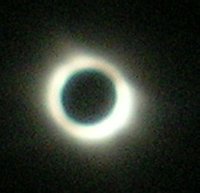Solar eclipse 2006 from Turkey
 Last year we went to Turkey to see the solar eclipse.
Last year we went to Turkey to see the solar eclipse.
Whilst everyone and their dog turned up with really serious cameras and telescopes, the photo that I was most impressed with is the one that you see here.
When I’d finished taking all the photos with the Nikon F3, I thought that I’d just have a go with my little digital and this is how that photo turned out. No messing around with settings, worrying about flash, or anything in fact other than zooming in (all of x3).
However, no matter how good the photos or video you’ve seen, it’s absolutely nothing like the experience that you’ll get when seeing a total eclipse of the sun. How can I describe it? When the eclipse is nearly at the point of totality (about 10 minutes before the full eclipse starts), things start to become quite strange. Flowers close up, the birds settle down for the night and it gets quite cool. All this is happening in the middle of the day, of course. The lighting is VERY strange. It’s not like sunset as you might expect because the sky is light around the edges and only getting dark in the middle. It’s so peculiar that it almost feels like you’re sitting on some alien planet. One thing that everyone does for the eclipse is to spend a whole lot of time taking photos but when you get the chance to see one, make sure that you reserve some time to just sit back and enjoy the experience. You need to make a point of reserving time too because the whole thing only lasts a few minutes.
You can book professional tours to see eclipses but I found that the best bet was to go with those organised by the Irish Astronomical Association. The “professional tours”, by and large, tend to be run by normal holiday companies who’ve just hired someone to give a talk about the eclipse but the amateurs in the IAA are just obsessed by the whole thing and no effort is spared to make sure that the country chosen has the best weather prospects and the best spot is arranged for the day itself within that country plus you don’t have just one “expert” along, you have dozens.
The only two coming up soon in “sensible” locations are in 2008 in Russia (in the middle of nowhere) and in 2009 in northern China (not too far from Shanghai where we list apartments) which will both be quite expensive to reach and the weather prospects aren’t great (you obviously need clear sky on the day). See the NASA eclipse site for more information as to where to see them.
The final and, for some, perhaps the most important point is that a solar eclipse only lasts about 5 minutes at most and therefore ’tis best to make the eclipse trip part of a general holiday. This also makes it somewhat easier to justify the expense to the rest of the family. With that in mind, the best bet coming up is probably 2009 in China which has loads of things to see vs not really that much in the middle of Siberia in 2008.
Copyright © 2004-2014 by Foreign Perspectives. All rights reserved.
I am amazed by how good photos taken with the point and shoot digital cameras can be. I couldn’t be bothered with taking photos in the past, carrying a bulky camera, fiddling with knobs, waiting and paying to have photos developed. The digital camera is so compact, you take lots of photos of the same thing and then choose the best ones right away. It also makes uploading photos to a website so simple.
They’re certainly handy but I think it’s sad that their arrival is likely to mean that we are the last generation who’ll be able to look at photos of their great-grandparents. We can easily lift up such a photo and look at it but if that photo is held in some ancient computer media, chances are that our great grandchildren won’t have anything capable of reading it.
After all, if NASA can lose large chunks of its data in this way (see http://www.businessweek.com/archives/1998/b3574124.arc.htm), what hope is there for the rest of us?
You’re probably thinking that printing said photos will solve the problem but the problem is that the majority of inks used by normal folk fade dramatically over time. Even that assumes that you print them in the first place.